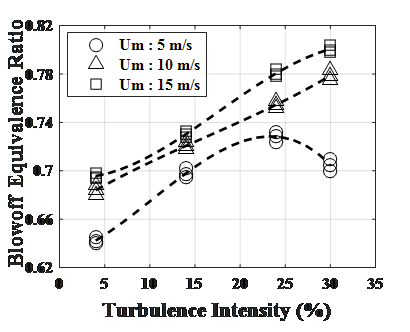Combustion Characteristics and Blowoff Behavior of Highly Turbulent Premixed Flames Using Different Fuels
Sponsors: United Technologies Corporation and National Science Foundation
Graduate Student: Bikram Roy Chowdhury (PhD candidate)
Undergraduate Student Researcher: Cory Rice
Project Summary
This project is an extension of our earlier projects on bluff-body stabilized premixed flames and their blow-\off behavior. We are now studying flames under high degree of turbulence (turbulent velocity up to 40 % the mean) and turbulence Reynolds numbers reaching 8000 based on turbulent velocity u’ and the integral length scale of turbulence. In addition to effects of turbulence, fuel effects under different turbulent flow conditions are being studied. Figure 1 shown below shows the effect of turbulence intensity on the flame blowoff equivalence ratio for propane flames. It is seen that flame blowoff equivalence ratio is affected by turbulence intensity in the incoming flow with higher turbulence intensities leading to higher flame blowoff equivalence ratios. Figure 2 shows the instantaneous images of a propane flame at two levels of turbulence intensity. At high turbulence levels flame becomes much more wrinkled and has ejections of the reactant mixture into the flame envelope. Effect of fuel type is shown in Fig. 3 where three different fuels have different blowoff equivalence ratios depending on the chemical reactivity of the fuel type. A unique experimental apparatus allows pre-vaporization of liquid fuels in the apparatus and it allows study of premixed flame behavior of different fuels without the complications of fuel spray formation and spray turbulence interactions. In this project, we explore a range of turbulent flame conditions as shown on the Borghi diagram in Fig. 4.

Variation of Blowoff Equivalence Ratio with respect to turbulence intensity for propane with reactants at 400K

Instantaneous flame front topography for propane flames at 4% (left) and 30% (right) turbulence intensities for Um=10 m/s, φ=0.8 (Red Lines represent the flame edges and green lines enclose the pockets of reactants present in the product region)

Blowoff equivalence ratio for different fuels

Borghi diagram for the six fuels: methane (![]() ), propane (
), propane (![]() ), ethylene (
), ethylene (![]() ), ethanol (
), ethanol (![]() ), n-decane (
), n-decane (![]() ) and toluene (
) and toluene (![]() ) at different turbulent Reynolds numbers.
) at different turbulent Reynolds numbers.